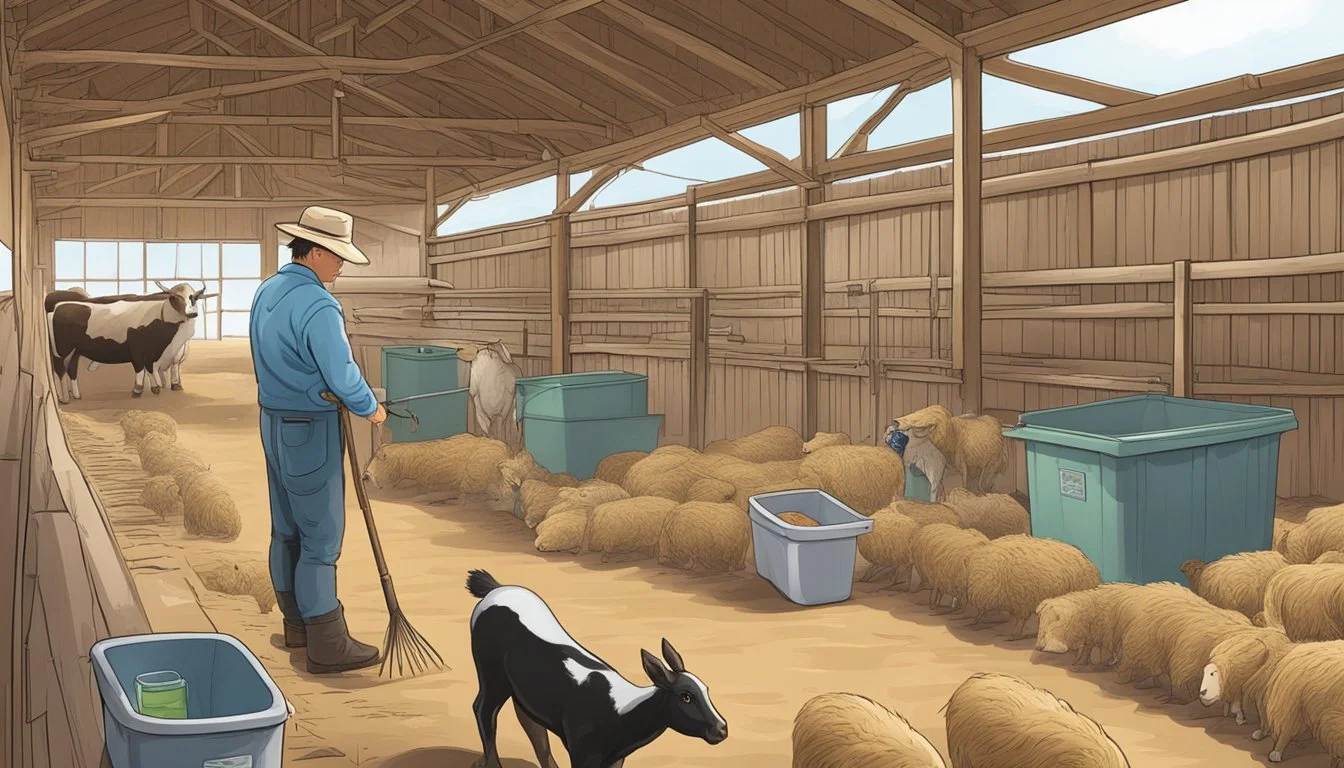How do I Ensure Good Herd Health and Biosecurity
Essential Strategies for Livestock Management
Maintaining good herd health and robust biosecurity measures are foundational to the success of any livestock operation. Herd health is the lifeblood of sustainable livestock production, and it is contingent on a variety of factors including nutrition, veterinary care, and disease prevention practices. Biosecurity complements these efforts by reducing the risk of disease entering or spreading within a herd through the implementation of stringent management protocols. Together, these practices are critical in supporting the overall health and productivity of livestock, ensuring that producers can meet the twin goals of economic viability and animal welfare.
Producers must adopt a proactive approach to herd health by establishing a comprehensive health management plan. This includes recommended practices for improving herd health, such as a clean environment, an adequate nutrition program, and effective reproduction practices, all tied together with quality record-keeping. Addressing biosecurity involves creating and adhering to a biosecurity plan that details routine procedures and outlines actions to take in the event of a disease outbreak. Such a plan often incorporates measures like controlling farm access, managing animal movement, and ensuring sanitation of equipment and vehicles.
Attention to biosecurity not only prevents the incursion and dissemination of diseases but also serves to protect the broader agricultural community and food supply. Producers can enhance their biosecurity by assessing risk points and establishing protocols such as quarantine for new or returning animals, which can significantly mitigate the risk of disease transmission. By rigorously applying these health and biosecurity strategies, livestock operations can maintain herd vigor and resilience, guard against production losses, and contribute to the overall stability of the agricultural sector.
Understanding Herd Health
Achieving optimal herd health is pivotal for the economic success and sustainability of any livestock operation. Vigilance in disease recognition and prevention is paramount, requiring proactive management and veterinary oversight to maintain a healthy herd status.
Recognizing Common Diseases and Their Impact
Livestock can be afflicted by a spectrum of common diseases, many of which have the potential to be contagious and severely impact animal health and productivity. Symptoms to watch for include changes in behavior, appetite, or milk production. Infectious diseases like bovine tuberculosis or foot-and-mouth disease can lead to significant economic losses due to their rapid disease spread. Acquiring knowledge about the signs, diagnosis, and effects of these animal diseases is critical for timely intervention.
Disease Prevention Through Effective Livestock Management
Effective livestock management involves comprehensive husbandry practices that minimize the introduction and transmission of pathogens. This encompasses biosecurity measures such as effective sanitation, control of parasites, and environmental management. Implementing quarantine protocols for new or returning animals can curtail the entry of infectious diseases into an established herd, safeguarding the collective health status.
Veterinary Involvement and Regular Health Checks
Regular evaluation by a veterinary professional is essential to maintain herd health integrity. Veterinarians play a critical role in the development of vaccination schedules, treatment plans, and overall health strategies. They help in early disease diagnosis and proper treatment administration, which are crucial in combating disease spread and safeguarding against new, emergent disease threats to the herd.
Biosecurity Fundamentals
Effective biosecurity is pivotal for maintaining the health and productivity of livestock. A successful biosecurity strategy minimizes the risk of disease introduction and spread. It includes a robust plan, practical protocols, employee training, and controlled access systems.
Developing a Comprehensive Biosecurity Plan
Creating a biosecurity plan is the cornerstone of protecting farm health. This plan should map out every process related to animal health, including vaccination schedules, quarantine measures for new or sick animals, and manure management. The plan must be farm-specific, addressing unique risks and outlining preventative measures. It should involve regular updates to equipment and clothing policies, including footwear, to prevent external contaminants from entering the farm environment.
Implementing Biosecurity Protocols on the Farm
On-the-ground application of the biosecurity plan involves several key protocols. These include proper disinfection and sanitation practices, such as using bleach solutions to clean surfaces and machinery. Isolation zones should be established for new or ill animals to prevent disease transmission. Additionally, storage and disposal systems for feed, bedding, and waste products must be managed to avert potential contamination.
Training and Practices for Farm Employees
Farm employees are central to successful biosecurity implementation. They should be trained on biosecurity protocols, from hand washing to handling sick animals and managing clothing and boots to avoid cross-contamination. Personnel should be knowledgeable about diseases like COVID-19 and understand the importance of reporting signs of illness immediately. Proper husbandry practices and regular vaccination programs are also part of their responsibilities.
Monitoring and Managing Visitor Access
Visitor control is another critical aspect of farm biosecurity. Farms should establish guidelines for visitor access, including disinfection of footwear and clothing upon entry. Fences and sign-in records ensure traceability and compliance. Visitors should be kept away from high-risk areas and provided with appropriate protective equipment when necessary.
In maintaining biosecurity, attention to detail and strict adherence to established protocols are key to protecting the health of livestock within the United States.
Herd Health Monitoring
Ensuring the health of livestock is critical for the success of any farming operation. Effective herd health monitoring involves consistent tracking and surveillance to maintain optimal animal health and prevent the spread of diseases.
Tracking Vaccination History and Schedules
Vaccination Program: Developing a robust vaccination program is essential for preventing infectious diseases within a herd. It is the responsibility of farm managers and veterinarians to maintain a comprehensive vaccination history for each animal. A detailed record should include the type of vaccine administered, the date of vaccination, and any booster shots given. Tracking these schedules ensures that no animal misses critical vaccinations, thereby maintaining the collective health status of the herd.
Example Vaccination Schedule:
First vaccination: At 8 weeks of age
Booster shots: According to the vaccine manufacturer's recommendations or vet's advice
Routine Surveillance for Early Disease Detection
Early Disease Detection: Surveillance is a key component of herd health monitoring. Routine health checks by a veterinarian can uncover early signs of illness, allowing for swift treatment. This proactive approach reduces the spread of disease and minimizes the risk of an outbreak. Farms should implement regular checks to monitor the health status of the herd and take appropriate biosecurity measures.
Signs to Watch For:
Unusual changes in behavior or appetite
Signs of discomfort or distress
Abnormal discharges or sudden weight loss
Utilizing technology to monitor herd health can provide real-time data and alert the farm management team to potential health issues before they become widespread problems. Maintaining the health of a livestock population is a continual process that requires vigilance and dedication to strict biosecurity practices.
Enhanced Biosecurity Measures
Enhanced biosecurity measures are critical in preventing disease outbreaks within livestock populations. These measures include stringent protocols for vermin and pest control, feed and water system cleanliness, and waste management.
Controlling Vermin and Pests
Livestock farms often attract vermin such as rodents and flies, which can carry and spread diseases. It is essential to implement deworming schedules and use traps or baits in a strategic manner to control these pests. Keeping storage areas for feed secured and limiting their access discourages pest inhabitation, reducing the risk of contaminated feed.
Rodents: Regular inspections and placing rodent traps.
Flies: Installing fly repellents and maintaining clean facilities.
Maintaining Cleanliness in Feed and Water Storage
Contamination of feed and water can be a direct path for disease into a herd. To prevent this:
Feed storage containers should be sealed and protected from moisture and pests.
Water systems must be regularly cleaned to prevent the growth of algae and bacteria.
Feed: Use of airtight containers. Water: Frequent testing and sanitation of water supplies.
Safe Disposal of Manure and Other Waste
Proper disposal of manure and other farm waste is imperative to prevent the spread of pathogens. Manure should be stored away from animals and removed from the property regularly. Safe disposal also includes proper carcass disposal methods following state and federal regulations.
Manure: Regular collection and safe composting methods.
Waste: Designated waste handling areas far from animal pens.
Animal and Equipment Management
Effective herd health and biosecurity hinge on meticulous management of new animal introductions and rigorous cleanliness protocols for equipment and vehicles. These controls are crucial to prevent the spread of contagious diseases and ensure overall farm biosecurity.
Managing Introductions of New Animals
When introducing new animals to a herd, it is essential to implement an isolation protocol. Initially, new livestock should be kept in a quarantine area separate from the rest of the herd. This isolation period allows for health assessments and reduces the risk of disease introduction. For example:
Quarantine Period: Set a minimum of 30 days for isolation.
Health Checks: Perform thorough veterinary examinations and testing before integrating new animals with the existing herd.
Cleaning and Disinfecting Farm Equipment and Vehicles
Cross-contamination through equipment and vehicles can be a significant risk factor for disease spread. To address this, a routine for cleaning and disinfecting must be established:
Disinfection Protocol: Develop a protocol for the disinfection of boots, clothing, and tools after every use.
Vehicle Hygiene: Ensure vehicles that enter the farm are clean and disinfected, especially if they have been in contact with other livestock facilities.
By strictly managing animal introductions and maintaining cleanliness in farm equipment and vehicles, farmers can preserve herd health and uphold robust farm biosecurity standards.
Farm Access Control
Effective farm access control is critical in maintaining herd health and biosecurity. By securing farm boundaries and regulating traffic, farms can minimize the risk of disease transmission and ensure a safe environment for livestock.
Securing Farm Boundaries
To secure farm boundaries, it's crucial to have robust fencing systems in place. Fences should be regularly inspected and maintained to prevent unauthorized entry. The use of signage to alert visitors of entry protocols is recommended. Additionally, gates should be kept closed and locked when not in use, particularly those leading to livestock areas.
Fences: Durable and regularly inspected
Signage: Clearly stating entry protocols
Gates: Closed and locked as standard procedure
Regulating Traffic In and Out of Production Areas
Regulation of movement is key to controlling the spread of pathogens. All vehicles entering the farm should be subject to disinfection procedures, and parking assignments should be made to avoid contamination of production areas. The farm must provide disinfection stations for footwear and vehicles.
Employees and visitors must adhere to on-farm protocols which include changing into farm-specific clothing and footwear, or using protective covers on their boots. Keeping log records of all visitors helps track potential contamination sources.
Vehicle Disinfection: Implement procedures for all incoming vehicles
Footwear Protocol: Disinfection stations; farm-specific or protective covers
Clothing and Gloves: Use of farm-specific attire and disposable gloves
Access Log: Keep records for traceability
By being diligent in these practices, farms effectively manage biosecurity risks associated with external and internal traffic.
Efficient Record Keeping
Efficient record keeping is fundamental in managing a healthy herd and maintaining strict biosecurity protocols. Accurate records help track animal health, inform biosecurity measures, and are essential to managing a successful farming operation.
Documenting Health Status and Biosecurity Measures
Health Status Records are critical for monitoring the wellbeing of the herd. They should include:
Individual animal identification
Daily health observations
Vaccination history
Treatment records
Test results for diseases
Keeping these records up-to-date ensures that farmers can quickly respond to health issues and apply targeted treatments, reducing the risk of widespread infections.
Biosecurity Plans need to be thoroughly documented to protect the herd from infectious diseases. These records might consist of:
Visitor logs detailing all farm access
Cleaning and disinfection routines
Quarantine procedures for new or sick animals
Equipment and vehicle movement records
Proper documentation of biosecurity measures assists in identifying potential risks and implementing strategies to mitigate them. It also demonstrates a commitment to animal health and management practices that support farm sustainability.
Each entry should be clear and concise, targeting the specifics of the biosecurity or health event. This allows for streamlined management, rapid response to potential outbreaks, and evidence-based decisions in the operation of the herd.
Special Considerations for Different Livestock Types
When managing the health and biosecurity of livestock, it is essential to recognize that each type of livestock requires different management strategies. These strategies must be tailored to meet the unique needs of poultry, cattle, and pigs, ensuring health risks are mitigated and biosecurity is maintained.
Poultry Farming Biosecurity
In poultry farming, biosecurity measures are critical to prevent the spread of diseases such as avian influenza. It includes strict visitor control, limiting access to essential personnel and implementing disinfection procedures for both people and equipment entering the premises. Vaccination history and flock health records should be meticulously maintained.
Cattle Herd Health and Biosecurity
For cattle, including both dairy farms and beef production, emphasis should be placed on vaccination protocols and nutritional management. Individual identification of each animal helps in tracking health records and managing preventative care. Programs for controlling internal and external parasites are vital components of a cattle herd health regime.
Pig Farm Biosecurity Measures
Pig farms should focus on controlling the entry of new animals and ensuring they are quarantined before integrating with the existing herd. Biosecurity measures are crucial to managing risks of diseases such as porcine reproductive and respiratory syndrome (PRRS). A sound biosecurity plan can significantly reduce the risk of infectious agents entering the farm or spreading within the herd.
Financial and Legal Aspects of Herd Health
Effective biosecurity measures are fundamental for maintaining herd health, reducing financial risks, and complying with United States regulations. Implementing stringent biosecurity protocols can have a significant impact on farm profitability and help in adhering to the legal standards required for livestock management.
Biosecurity Impact on Farm Profitability
Biosecurity measures are investments in the wellbeing of a herd. They often require upfront costs but can result in long-term savings by preventing widespread disease outbreaks. An outbreak can lead to high veterinary costs, reduced productivity, and lost market access, all of which severely impact profitability. For instance, investing in disinfection procedures and quarantine facilities for new animals can help mitigate the risk of introducing pathogens to the herd.
Understanding Biosecurity Regulations in the United States
In the United States, biosecurity regulations are established to safeguard the nation's food supply. Livestock producers must familiarize themselves with relevant statutes such as the Animal Health Protection Act, which gives authorities the power to take action to prevent, detect, control, or eradicate pests and diseases. Moreover, state-level regulations may impose additional requirements for livestock health, including mandatory vaccination programs and movement reporting. Non-compliance can lead to fines, legal action, and compromised market access. It's imperative for producers to stay informed about these regulations to ensure their operations remain within legal guidelines and to protect their financial interests.
Emerging Threats and Continuous Improvement
In the constantly evolving landscape of animal agriculture, biosecurity and herd health management must adapt to emerging threats. The application of robust epidemiological knowledge, especially in the wake of diseases like COVID-19, is critical for the sustenance and safety of livestock.
Staying Informed on Biosecurity Research and Trends
They must prioritize remaining abreast with the latest biosecurity research. Farmers, veterinarians, and livestock managers can do this by following studies and trends that may indicate potential risks to animal populations. Continuous education can involve engaging with research from biosecurity experts and implementing industry best practices that evolve in response to new data.
Adapting to New Challenges in Herd Health
Adaptation is key when responding to new challenges in herd health. As pathogens evolve, so too must the strategies for herd management. For example, measures like quarantine for new animals, vaccination programs, and diligent health monitoring are essential to mitigate the risk of diseases spreading. Managers can utilize technologies in precision livestock farming to closely monitor herd behavior and catch early signs of disease.








